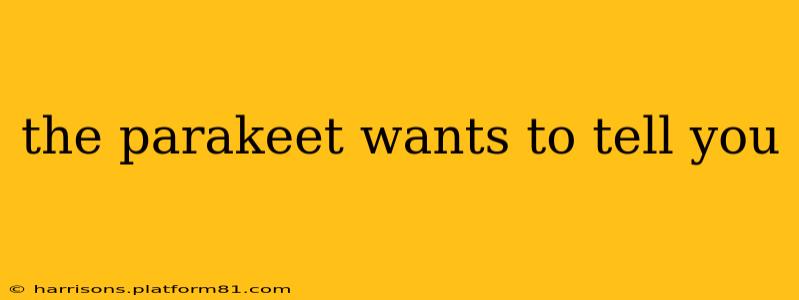The Parakeet Wants to Tell You: Decoding Your Feathered Friend's Communication
Parakeets, those vibrant, chirping companions, are far more communicative than many realize. While they may not be able to articulate Shakespeare, their vocalizations, body language, and even subtle behaviors offer a rich tapestry of information. Understanding what your parakeet wants to tell you can significantly strengthen your bond and improve its overall well-being. This comprehensive guide delves into the various ways parakeets communicate, helping you decipher their messages and become a better companion.
What are the different ways a parakeet communicates?
Parakeets communicate primarily through a combination of vocalizations, body language, and subtle behavioral cues. Their chirps, whistles, and squawks aren't random noises; they convey a wide range of emotions and needs. Body language, including posture, wing position, and head movements, plays a crucial role. Finally, subtle behaviors like feather ruffling or changes in appetite can also indicate underlying issues or desires.
How do I know if my parakeet is happy?
A happy parakeet is usually active, playful, and vocal. They’ll engage in activities like preening, singing, and exploring their environment. Their chirps will be generally cheerful and melodic. A relaxed posture, with soft, sleek feathers, is another good indicator of contentment. Look for signs of active engagement with their surroundings and their favorite toys. A parakeet's happy chirps often have a higher pitch and more upbeat rhythm compared to their distress calls.
What are the signs of a stressed or unhappy parakeet?
Conversely, a stressed or unhappy parakeet may exhibit several behavioral changes. These include excessive preening or feather plucking, lethargy, changes in appetite (eating less or more), aggression towards you or other birds, and repetitive behaviors like pacing. Their chirps might become shrill, high-pitched, or frequent, showing anxiety. They may also hide or avoid interaction. Changes in their droppings can also signal underlying health problems contributing to their distress.
What does it mean when my parakeet is biting me?
Biting, while unpleasant, is often a sign of miscommunication or underlying issues. A parakeet may bite out of fear, if they feel threatened or cornered. Sometimes, biting can be a sign of hormonal changes, especially during breeding season. It's crucial to understand the context of the bite; if it's a playful nip, it's different from a hard, aggressive bite. Consistent, harsh bites warrant attention and may require behavioral modification techniques. Understanding the root cause—fear, territoriality, or hormonal changes—is key to resolving the biting behavior.
My parakeet keeps chirping excessively, what does this mean?
Excessive chirping can stem from several factors. A lonely parakeet often chirps more frequently to seek attention or companionship. It could also be a sign of boredom, especially if it doesn't have enough enrichment in its environment. Other times, it's simply expressing itself! However, sudden changes in vocalizations, particularly more frequent or shrill chirps, can indicate stress or illness. Observe your parakeet's behavior and look for other signs to determine the root cause.
How can I better understand my parakeet's communication?
Spending quality time observing your parakeet is essential. Pay attention to the nuances of their chirps, their body language, and their overall behavior. Read books, articles, and forums dedicated to parakeet behavior to learn more about their typical communication patterns. Consider consulting an avian veterinarian or a certified avian behaviorist if you are struggling to decipher your parakeet's communication or suspect an underlying issue.
By paying close attention to the subtle cues your parakeet provides, you can build a stronger, more rewarding relationship based on mutual understanding and trust. Remember that understanding your parakeet's communication is a journey, not a destination. Continuous observation and learning will allow you to become fluent in the language of your feathered friend.
